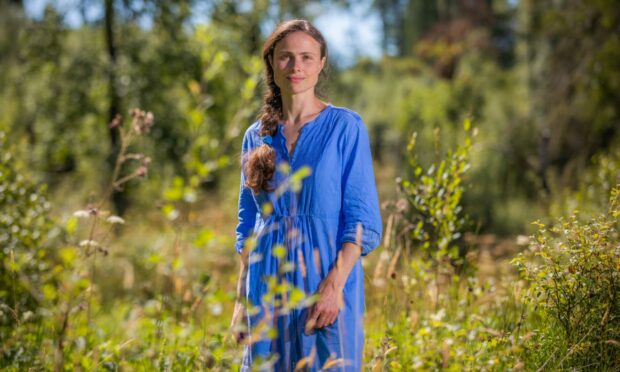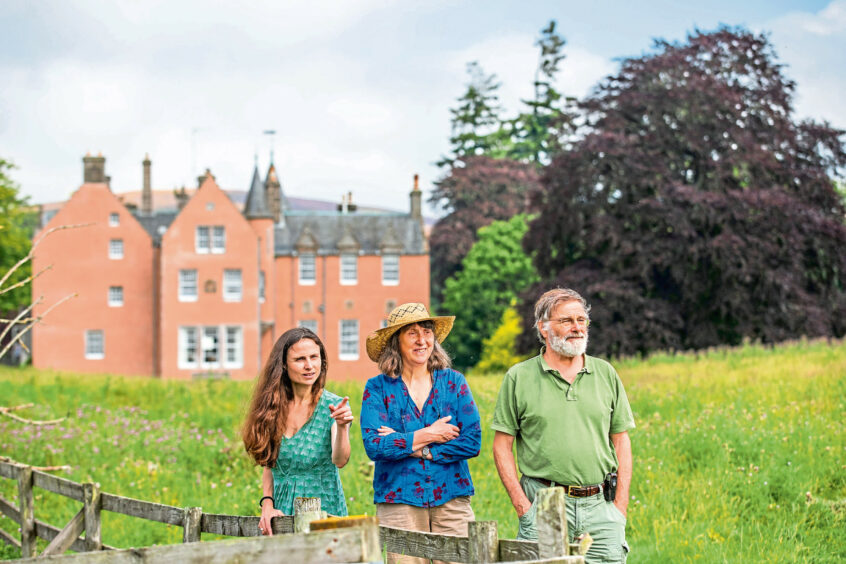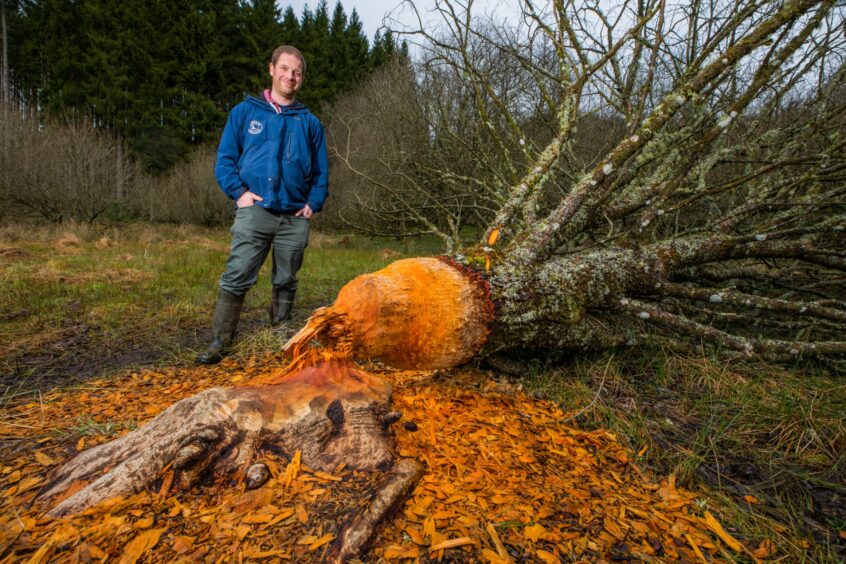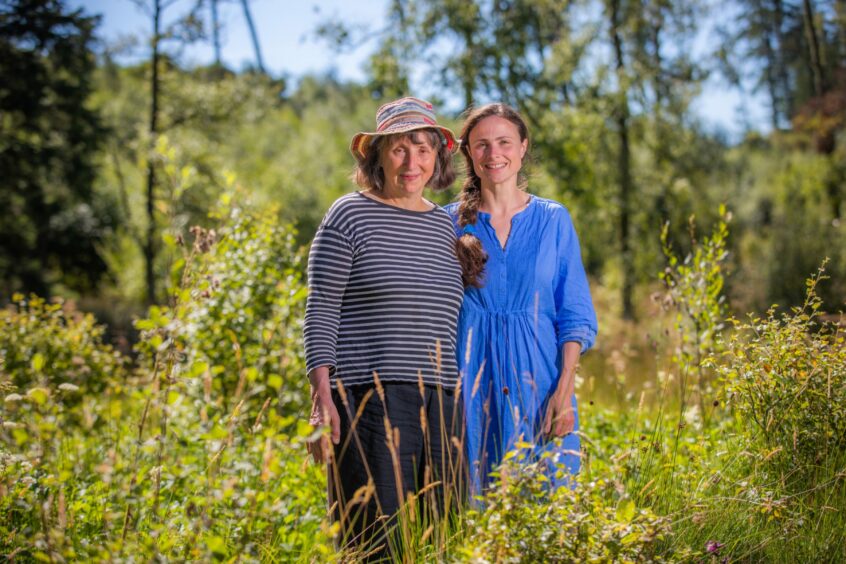One thing did not sit right with Sophie Ramsay as she pondered taking over one of the best known eco-tourism estates in Perthshire.
The shooting syndicate who still paid to kill pheasants on her family’s land.
“I put my foot down about pheasant shooting,” the wild land manager at Bamff Estate near Alyth, says.
“I don’t think either of my parents were particularly enthralled with it, but it has a long cultural history, I guess.”
Rewilding over pheasant shooting
Sophie grew up with pheasant shooting.
“It was normal,” she continues. “But as I got older and expanded my world I realised that lots of people hated things like that.
“I noticed I had quite a lot of sympathy with those people.”
Sophie’s family are not your typical owners of a 1,300 acre country estate.
Her dad, Paul, and mum, Louise, are well-known as rewilding champions.
The couple have spent decades working to reintroduce native flora and fauna. The family did so long before a movement developed to support such changes.
They are best known for supporting beavers, and are often linked to the species establishing itself in Tayside.
The estate stopped grouse shooting in the late 1980s. The Ramsays planted a native pinewood on the land instead.
Yet pheasant shooting lingered. A reminder of the estate’s long history. Until Sophie nudged her parents.
“When we decided to do a rewilding project, it felt that it would be really hypocritical to continue pheasant shooting,” she continues.
“You introduce a non-native species and then you feed it. It is basically a kind of farming.
“That disturbs the ecological balance.”
Shooting in Scotland debate in the spotlight again on ‘Glorious Twelfth’
Shooting in Scotland, more generally, is back in the headlines.
The traditional start to the driven grouse shooting season on August 12th usually brings forward well-worn arguments for and against the sport.
There are marked differences between shooting grouse and pheasants and the land types and management work undertaken to prepare for each.
Grouse shooting takes place on the moors and heather of the Scottish uplands where forests across the country are dotted with pheasant feeders and young birds in preparation for autumn and winter shoots.

Yet the totemic date in August marks the day when the sport in general re-enters the limelight.
Alex Hogg, MBE, is chairman of Perth-based Scottish Gamekeepers Association. He has highlighted grouse shooting brings over £30m to remote communities in a short window.
Mr Hogg has suggested the income could provide much needed respite to rural businesses affected by the cost-of-living crisis.
He has figures which suggest game shooting and angling sustain more full-time direct jobs than all of Scotland’s large conservation charities combined.
But owning an estate is no longer automatically linked to shooting in the way it once was.
The rewilding movement – restoring once native plants and animals – plus the climate crisis have put new energy behind alternative land uses.
Estates such as Bamff are at the forefront of the change, but they are not alone.
Cameras replace guns at Doune
Pheasant shooting stopped at Tom Bowser’s Argaty estate near Doune in 2019.
Grouse shooting on the upland part of the family’s land ended long before that – in the 1920s, Tom thinks.
“I grew up around shoots and went beating [frightening birds into the air, towards guns]. I never really felt that comfortable with it, but never really questioned it that much either until becoming an adult.
“But it never really sat that well with me. I couldn’t see where the enjoyment was. And the more you look at some of the issues around it the more against it I became.”
But he notes the landscape at Argaty would not “look at it does” without the sport’s influence.
“We’ve got a lot of woodland, we’ve got hedgerows, we’ve got ponds.
“It’s kind of ironic that what we’ve based our rewilding on is because previous generations like to fire at things.
“When I get pious, I have to remember that.”
Red kites spark rewilding success
These days, the red kite reigns supreme at Argaty.
Tom’s family runs central Scotland’s only red kite feeding station, attracting scores of visitors with binoculars, not guns, in their hands.
“They’re [red kites] the ones that made it all possible. They came onto the farm in 1996 after they’d be reintroduced on a neighbouring estate and they’ve been here ever since.
“We’d never had gone down the rewilding line if it wasn’t for that bit of good fortune.”
Yet, while things are changing in a small way, he is cautious about over-stating the case.
“You’re seeing a real change in land use and land ownership patterns going on across Scotland.
“But we’ve got a long way to go. We can’t kid ourselves about that.
“Many estates are still run for very intensive forms of shooting, which must have consequences for the environment.”
Shooting’s supporters point towards estates where land managers balance supporting greater biodiversity alongside more traditional sporting interests.
‘A terribly tedious way of spending your time’
Back at Bamff, estate owner Paul Ramsay is recapping his own shooting memories from when they stopped supporting grouse shooting in the 1980s.
The Ramsays have now reforested the entire 500 acre Bamff hill with native species which, as recently as the 1980s, was the favoured spot of a Dundee-based shooting syndicate.
“In any case, I was not interested in grouse shooting. I was interested in re-foresting Scotland,” Paul explains.
“I associated it with long, weary days, wandering along in a line. It just seemed to me a terribly tedious way of spending your time.
“When I learned that driven grouse shooting could only work financially if you killed everything that competed with it.
“So it wasn’t possible to run a successful grouse shoot unless you removed the hen harriers and the peregrine and you slaughtered the eagles.
“The whole thing was deeply unattractive to me.”
His wife Louise is the managing partner on the estate.
She says rewilding is not only a family passion, but key to a sustainable financial future for the estate and the family.
Paul quickly left grouse shooting behind and the couple were “nudging in the direction” of stopping pheasant shooting, even before Sophie’s interjection.
“The actual money that the shoot brings in is not very much really. Financially it made a little bit of a difference, but not very much in terms of the turnover of our tourism business.
“People come to us now to watch beavers and other wildlife. They come for the feeling of being surrounded by nature.
“It is still unusual in Scotland to see land that is neither farmed nor managed for sport.”
But if rewilding, rather than game shooting, continues to establish itself in the way that it has at Bamff and Argaty then that type of wild land may become a little less unusual every year.















Conversation